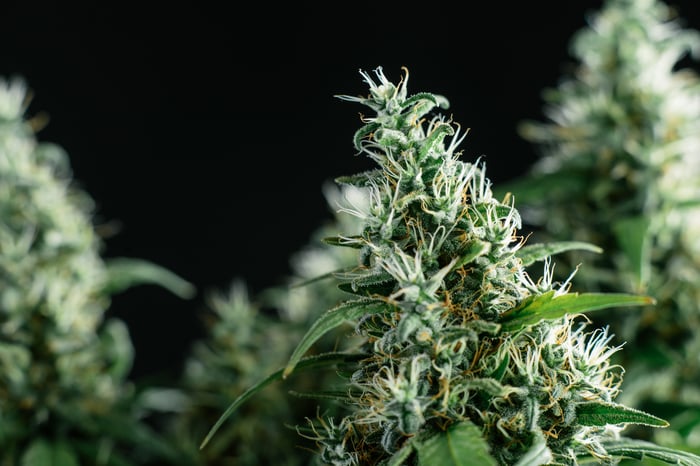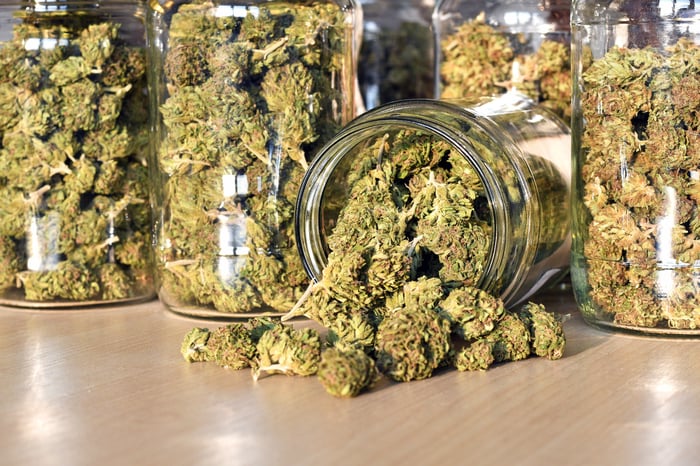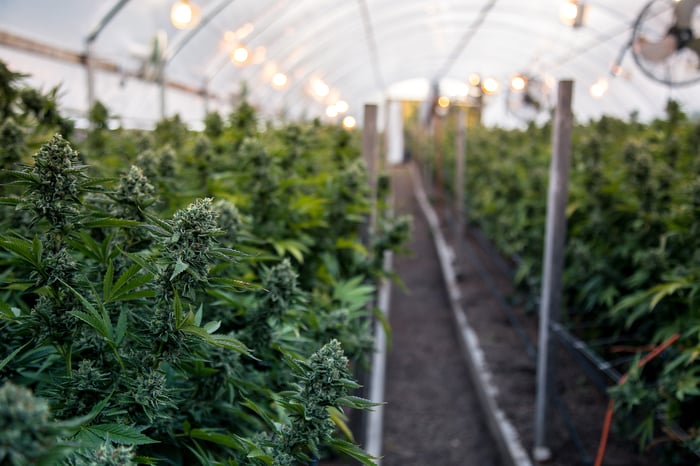The marijuana industry is budding before our eyes, but blink and you might miss a big development.
Arguably the most fluid aspect of the cannabis industry has been the constant updating and reshuffling of marijuana production. Growers have been in a pretty steady escalation battle with one another for more than a year now. Even though Canadian market demand may only reach 1 million kilograms a year, with more than 40 countries worldwide having given the green light to medical pot, the sky is seemingly the limit for long-term weed demand.

Image source: Getty Images.
Pot stocks have been tackling this demand in a variety of ways. We've seen organic projects that could generate in excess of 150,000 kilos, partnered projects that convert existing vegetable-growing greenhouses to cannabis production, and plenty of acquisitions. This means the peak production landscape tends to change frequently. Following a recent acquisition by HEXO (HEXO), as well as upped production forecasts from The Green Organic Dutchman (TGOD.F -8.13%) and CannTrust Holdings (CNTTQ), Canada's top 11 marijuana growers list looks a lot different than it did just a few weeks ago.
And if you're curious as to why I chose 11, it's because these are the only 11 pot producers expected to top 100,000 kilos per year.
1. Aurora Cannabis: Approximately 700,000 kilos
Absolutely no surprise here, with Aurora Cannabis (ACB 12.87%) easily maintaining its pole position in terms of production. Aurora has received a big boost from acquisitions, which include MedReleaf for about $2 billion, ICC Labs in South America for about $200 million, and Saskatchewan-based CanniMed for $852 million. Aurora should have little trouble hitting 700,000 kilos in peak annual output by 2021 or 2022, but it has the available land to push production to as much as 1 million kilos a year, should it choose to do so.
2. Canopy Growth: Between 500,000 kilos and 550,000 kilos
The only marijuana stock within striking distance of Aurora with regard to production is Canopy Growth (CGC 20.65%). Canopy's fiscal third-quarter operating results showed that it had more than 4.3 million square feet out of 5.6 million square feet of cultivation space already licensed by Health Canada. Not only should this allow Canopy Growth to produce at least 500,000 kilos annually at average industry yields, but its ability to secure cultivation licensing so quickly may allow it to fill up dispensary shelves well before its peers.

Image source: Getty Images.
3. Aphria: 255,000 kilos
Despite a bevy of bad press since December, Aphria (APHA) remains (for now) the third-largest producer, with a company-estimated 255,000 kilos in yearly output. Most of this will come from the organically constructed Aphria One facility and the retrofitted Aphria Diamond facility, the latter of which represents a joint venture with Double Diamond Farms. Both projects are expected to yield 110,000 kilos and 140,000 kilos at peak annual output.
4. CannTrust Holdings: Between 200,000 kilos and 300,000 kilos
Surprise! Say hello to what might be the new No. 3 grower at some point: CannTrust Holdings. Following permitting issues with the town of Pelham over the phase 3 expansion of its Niagara facility, CannTrust decided to also consider outdoor growing as an option. With its recent fourth-quarter earnings release, the company guided to 100,000 kilos, in aggregate, once its phase 3 expansion (spanning 390,000 square feet) at Niagara is complete, as well as 100,000 kilos to 200,000 kilos in additional yield from the purchase of 200 acres of land which will be developed for outdoor growing. That could mean up to 300,000 kilos a year from CannTrust.
5. The Green Organic Dutchman: 219,000 kilos
The Green Organic Dutchman also recently reported its quarterly operating results and delivered a pleasant surprise. Having previously forecast 195,000 kilos of peak annual output, the company noted in its operating results press release that improved design and engineering updates at its facilities would lift peak yearly production to 219,000 kilos. Understandably, The Green Organic Dutchman still has a long way to go, with its entrance into the marketplace coming months after its peers. But based on sheer production, it's looking like a top-five producer when fully operational.

Image source: Getty Images.
6. HEXO: 150,000 kilos
Almost three weeks ago, HEXO announced an all-stock deal to acquire Newstrike Brands for 263 million Canadian dollars (close to $200 million). The friendly takeover not only brings well-known brands into HEXO's product portfolio, but it'll add a healthy amount of production. Having previously forecast 108,000 kilos a year, with close to 40% of this production heading to its home province of Quebec over the next five years via a supply deal, the Newstrike deal will allow HEXO to push to 150,000 kilos at its peak.
7. Aleafia Health: 138,000 kilos
Also in March, we saw Aleafia Health's acquisition of Emblem officially close. The combined company now owns 40 health clinics, which serve as a means to prescribe medical cannabis, as well as keep tens of thousands of patients loyal to its vertically integrated supply chain. That supply chain includes an expected 98,000 kilos from Aleafia and 40,000 kilos from Emblem. Thus, even though Aleafia Health's market cap is relatively small, its 138,000 kilos in projected peak annual output isn't.
8. Cronos Group: Approximately 120,000 kilos
Cronos Group (CRON -0.41%) may have received a lot of buzz on Wall Street following its $1.8 billion equity investment from Altria, but the company's 120,000 kilos of peak annual output slide it behind some marijuana stocks with markedly lower market caps. The bulk of Cronos Group's production will derive from its 850,000-square-foot joint venture project (Cronos GrowCo) and wholly owned subsidiary, Peace Naturals. Expect Cronos to aggressively use its newfound cash pile to boost its cultivation capacity in the quarters that lie ahead.

Image source: Getty Images.
9. OrganiGram Holdings: 113,000 kilos
Easily the most efficient grower on this list, New Brunswick-based OrganiGram Holdings aims to top out at 113,000 kilos a year, but it'll do so spanning just 490,000 square feet of growing space at its Moncton campus. OrganiGram's use of a three-level growing system in its rooms maximizes its cultivation space, leading to roughly 230 grams per square foot of yield. That's well over double the industry average, and it'll be instrumental in keeping per-gram growing costs down.
10. Tilray: Greater than 100,000 kilos
Previously, I had Tilray occupying a top-five spot on the growers list, with an expected 200,000-plus kilos of yearly output. But given the company's strategic readjustment that'll see it deemphasizing Canada in favor of the U.S. and Europe, I'm not entirely certain where Tilray's peak output future lies anymore. It has just over 850,000 square feet of aggregate cultivation space in Canada already, and is working on 250,000 square feet in Europe. This should get the company at or near 100,000 kilos. My suspicion is Tilray will look to expand its output more than this, but we'll need to await word from management for added clarity.
11. Emerald Health Therapeutics: Greater than 100,000 kilos
Bringing up the caboose is likely to be Emerald Health Therapeutics. Emerald Health formed a joint venture in 2017 with Village Farms International known as Pure Sunfarms. The retrofit of Village Farms' existing vegetable-growing greenhouses for cannabis production should yield more than 75,000 kilos spanning just over 1 million square feet. Add on Emerald Health's Agro-Biotech purchase and its Metro Vancouver facility and it should be able to surpass 100,000 kilos in peak annual production.
As always, expect more change to this list in the weeks and months that lie ahead.





